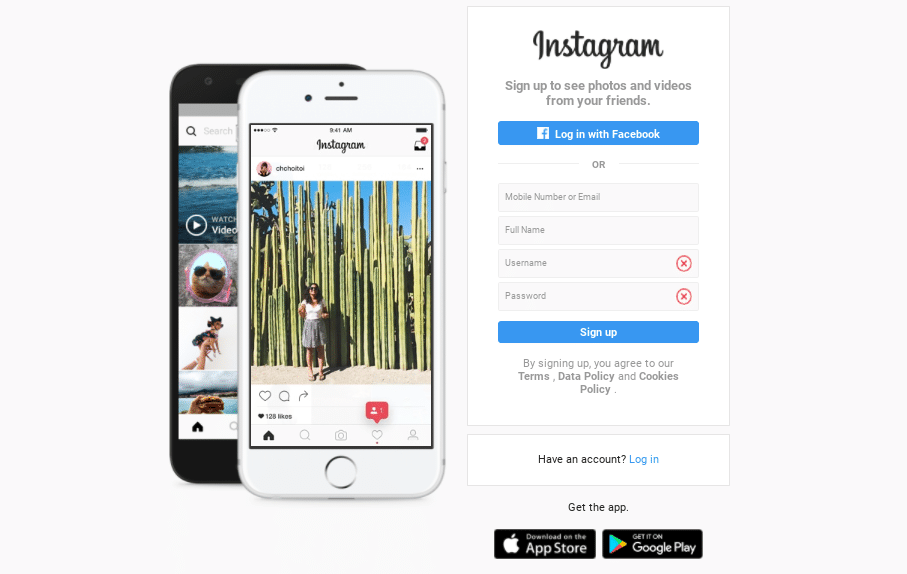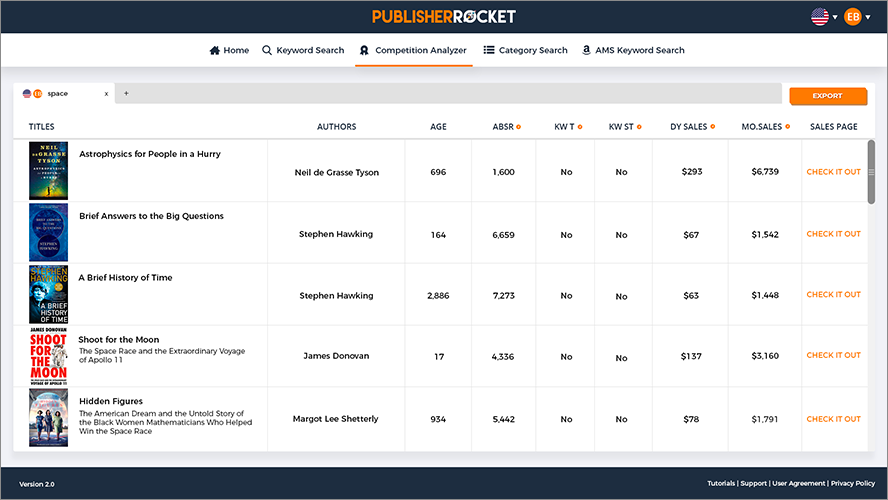Instagram continues to be one of the most popular social media platforms — and one of the most reader-friendly.
Thanks to the rise of Bookstagram (the vibrant community of book lovers, reviewers, and authors on Instagram), it’s become a powerful place to grow your author brand, build trust with readers, and connect with new fans.
In this article, we’ll look at how you can use Bookstagram to support your writing goals and grow your reach as an author.
You'll learn:
- What Bookstagram is — and how it helps writers build an audience
- How to set up a professional author Instagram page
- What to post (and how to stand out) in the Bookstagram world
Table of contents
- Why is Instagram good for authors?
- Instagram or Facebook? Do I need both?
- How to set up an Instagram author page
- What you should post on Instagram
- 4 Tips for Looking Like a Pro on Instagram
- Tools to use with Instagram
- Examples of Authors (and Bookstagrammers) Who Are Killing It on Instagram
- A List of the Best Bookstagram Hashtags
- Instagram for Authors: Final thoughts
Why is Instagram good for authors?
For starters, Instagram has a highly engaged user base, with readers, reviewers, and book lovers gathering under the #bookstagram hashtag and related communities.
While Instagram may not be the newest platform on the block, it remains one of the most author-friendly — especially if you're looking to share your books visually and build genuine relationships with readers.
You also get better visibility on Instagram compared to Facebook and Twitter. More than that, the rate of engagement with Instagram is better than all the others combined. This offers great potential for authors to reach new readers and develop stronger engagement with their existing fans.
Author Belinda Pollard used Instagram to grow her platform to great success. In her first six months, she met journalists who accepted book copies, found bookstore owners who agreed to stock copies of her book and connected directly with people who ended up purchasing her book. Not too shabby for six months’ work!
Here are some ways you can benefit from an Instagram account:
You can attract new readers.
The biggest benefit of using Instagram for authors is that it offers greater opportunities to grow your following. Because Instagram's users are so active, if you consistently post quality content (more about that later), people are more likely to read it and engage with you than on other social media sites.
Here are a few strategies you can use to grow your following:
- Follow bloggers who review books: If you do, it will increase the chances of your book getting reviewed.
- Connect with people who follow authors in your genre: Rather than connecting with other authors, look at their list of followers to find engaged readers.
- Use relevant hashtags: Make sure you’re using the right Bookstagram hashtags so readers, reviewers, and genre fans can find your work (more on this later).
You can connect with your existing audience.
Not only do you connect with new readers, but Instagram also makes it easier to get more familiar with your existing audience. The more your followers see you behind the scenes, the more they’ll see you as an authority in your field. Along with that, they’ll see you as a person, rather than just an author. Many writers use Instagram to give their audience a peek behind the curtains.
You can get more free attention compared to other platforms.
Instagram is newer compared to other social media such as Facebook and Twitter, which many would argue have reached their saturation point.
Facebook is full of ads and other messages these days, making it almost impossible to get good exposure on posts from your page.
Though there are ads and other messages on Instagram, it has not reached the saturation point–especially for authors. While Instagram is growing for authors, you can still get in somewhat early, which is a huge advantage.
You can keep people updated on new releases.
Some authors use Instagram to keep their fans and followers updated. In fact, you can keep your readers up-to-date on your entire writing process, from jotting down ideas all the way to publication. This way your book will be more top-of-mind when it becomes available for purchase — that's a good thing.
Instagram or Facebook? Do I need both?
Let’s face it. You didn’t become an author so you could spend hours on social media liking pages and commenting on posts. When it comes to social media, it can feel like you’re on a treadmill–always moving, but never getting anywhere.
So, do you need both Instagram and Facebook pages? Or can you just use one?
Personally, I think you do need a Facebook page — especially if you plan to run ads or build a broader author platform outside of Bookstagram.
Where Facebook pages tend to struggle is engagement. In the old days of Facebook, you could post to your page, and it would be seen by most of your followers. Now, only a tiny percentage of your audience actually sees your posts.
Instagram for authors comes in handy for connection. You’ll have direct access to your followers and they’ll be able to see more of your posts. Instagram also seems like a more personal platform as opposed to a Facebook page.
All that said, many readers are on one platform but not the other, so using both isn't a bad idea. You can recycle your content from one platform to the other to get more exposure without much more work.
How to set up an Instagram author page
When creating an Instagram page for your author business, you'll want to create a business page, instead of a personal account. Having a business account will give you access to ads, along with better reporting metrics for your author page. Creating an account with Instagram’s platform is easy.
1. Download the Instagram app
Unlike some platforms, Instagram was built with mobile in mind — and nearly all of Bookstagram runs through the app.
So, if you’ve never used Instagram before, you’ll want to download the app. This app is available on different devices such as smartphones and tablets. And you can find it in just about every app store available.
If you want to use Instagram on a desktop computer, visit the Instagram website.

2. Create an account
Once you have downloaded the app, launch it and create your Instagram account. There are two ways of creating the account:
- Sign up using your email address or you can use your phone number. Then provide the username you want to use on the account.
- Create it through your Facebook account. Login to your Facebook and then link your account. If you’ve used an author email to sign up for Facebook, this should be the option you choose.
If you have already created an account, you just need to sign in and then proceed to the profile page.
3. Connect to Facebook
When you first register with Instagram, you’ll automatically begin with a personal profile. However, if you want to use Instagram for your author business, connect your account to a Facebook business page.
To do that, complete the following:
- Click the profile icon to access your profile. You'll know you're on your profile when you see your posts and profile picture.
- From here, tap on the three parallel lines in the top right corner of the screen.
- Click the settings cog at the top of the menu.
- Tap on ‘Account.'
- At the very bottom of the ‘Account' menu, tap on ‘Switch to Professional Account.'
- Click the prompt to connect to Facebook. Select “Choose a page,” and set the page to “public.” Click “OK.”
- Instagram will then prompt you to connect or create a Facebook Page for your business. Just select your author page from the list, or create a new one if needed.
4. Complete the profile setup
To finish your profile, you must give an email, phone number, and address for your business. Fill in at least one of these contact fields to proceed. Don’t be surprised if the app auto-fills a part of this since it’s connected to your Facebook page.
Click “Done,” and go to your profile. A new graph icon should appear at the top of the Instagram app. This is your Insights page where you can find extra tracking and business metrics.
5. Create a new Instagram business page
Set a title for your page and choose the category that best describes your business. While there are over 1000 business categories you can choose from, you’ll most likely be selecting “author”.

6. Finish editing your profile
Go to your profile and click “Edit Profile.” Here you can add a photo, bio, and website link. Consider book Instagrammer Elizabeth Sagan’s profile for instance. In her Instagram profile, she includes a related Instagram page, an email for inquiries, and her most important link.

What Is Bookstagram (And Why It Matters for Authors)
Bookstagram is the book-loving corner of Instagram — a vibrant community of readers, reviewers, bloggers, and authors who share their love of books through photos, quotes, reviews, and aesthetic content.
If you’ve seen beautifully styled photos of books arranged with candles, coffee, plants, or seasonal props, you’ve seen Bookstagram in action.
For authors, Bookstagram isn’t just about being visual — it’s about being part of the conversation. The right presence can help you:
- Connect with genre-specific readers and reviewers
- Build anticipation for new releases
- Share your work in a way that feels organic and creative
- Grow long-term engagement through real relationships
And the best part?
You don’t need a huge following to get noticed. With consistent, quality content and the right hashtags, Bookstagram can help you build your brand one post at a time.
What you should post on Instagram
As mentioned earlier, what you post plays a huge part in how successful Instagram for authors can be. For maximum engagement, you’ll want to post quality content consistently. Here are a few ideas on what you can post on your Instagram page.
A peek into your life.
Bookstagram is full of creative ways to share your writing life — and the more authentic and personal your posts are, the more likely you’ll connect with readers.
If you post exclusive sneak peeks into your day, it will help you connect with your audience and be more relatable. While not all of your audience can relate to a book, they can relate to someone who enjoys time with their family and pets.
Share with your audience interesting things about your life — things that make you happy — and include some behind the scenes fun. Essentially, moments you’d want to share with friends.
Stephanie Danler offers her audience snapshots into her daily life, her writing process, and getting caught working on vacation (haven’t we all been there).

Inspiring quotes.
Quotes have been a staple of Instagram for years now. Inspiring quotes are easy to digest, very share-able, and have high engagement. Magazine and online course provider Foundr used mostly quotes to grow their Instagram page to over two-million subscribers.

You can even use quotes from your upcoming books. Melissa Frey, for example, has done this with her book the Prophecy of the Codex.
If your book includes memorable lines or emotional moments, turn them into stylized quote graphics — they fit right in with Bookstagram content.
News about Upcoming books.
You can turn to Instagram to promote any upcoming books that are on the horizon.
Cover reveals, unboxings, and countdown graphics are especially popular on Bookstagram, and they tend to get strong engagement when paired with the right hashtags.
Need Help with Your Keywords?
Take my full featured video course on how to select the best keywords and categories for your book.
Take the Course4 Tips for Looking Like a Pro on Instagram
1. Give a theme to all of your posts.
Since Instagram is a visual platform, many accounts have an over-arching theme to their profiles. The theme can come from the posts, or even the colors used. Booknerdbecky is a book blogger with a great account that has an incredibly consistent look and feel to it.

2. Use Instagram stories.
Stories are videos and images that stay at the top of your Instagram profile for 24 hours. They’re an awesome way to show glimpses of your daily life and share funny little tidbits. Instagram stories also have high engagement rates, with popular accounts boasting over a 92% completion rate.
Plus, when you reach the 10,000 follower milestone, you gain access to Instagram’s “swipe up’” feature. After swiping, followers are then taken to a link of your choosing outside of Instagram. Use this to direct people to your author website or to your book's sales page.
3. Keep it Relevant
While it's important to be yourself on Instagram, you also don't want to spread yourself too thin or post about every idea that you have. You want to keep things relevant to your intentions, which I assume (since you're a writer) have something to do with your writing.
You need to know what your target audience is, and then make sure you're delivering content that is relevant to that audience. Otherwise they will not engage with you as well, and that will sink your chances of getting picked up by Instagram's algorithm.
So pick that part of yourself that you want to shine the spotlight on, and angle each Instagram post to be a variation on that theme. It will make things a lot better.
4. Be Consistent
As with most social media platforms, consistency is key. That is why I generally recommend authors only pick one or two social media platforms that they like, then run with those. Because to be consistent on too many platforms would be exhausting after enough time, and would likely cause burnout.
So you'll want to keep posting, post similar content, and post all the time.
If this is a problem to constantly check into Instagram, you could consider using a service like Buffer to scheduled a bunch of posts all at once so they appear over time.
In addition to posting consistently, you should also engage consistently. By this I mean be sure to take time responding to comments, commenting on other people's Instagram pages, liking posts you find interesting, etc. This will also boost your chances of increased exposure.
Tools to use with Instagram
Bookstagram can be a powerful part of your author platform — but it also takes time and consistency.
Thankfully, a few tools can help you streamline your content, improve your visuals, and stay organized.
Linktree
One thing I don’t like about Instagram is their sub-par link sharing. Unlike other platforms, you can’t add links to your posts. In fact, you can only have one link in your bio, which is where a lot of accounts steer their users to. Luckily there’s a tool called Linktree that allows you to store all your links on an easy to use dashboard. This way, when a user clicks your Instagram bio link, they’ll see various links and resources.
This is great when you want to give people the option of buying your book, reading your blog, or downloading a recent podcast interview, etc. Here’s an example of what that might look like.

A Scheduling App
There are plenty of apps that let you schedule Instagram posts. Back in the early Instagram days, you had to post manually. And for marketers, it was a nightmare.
Luckily, today things are a much less tedious. Platforms like Later and Hootsuite are helpful Instagram scheduling tools.
Design Tool: Canva
One of the easiest ways to make eye-catching Bookstagram content is with Canva. It offers drag-and-drop templates for quote graphics, cover reveals, Reels thumbnails, and more — all perfectly sized for Instagram.
You don’t need a design background to make something beautiful.
Examples of Authors (and Bookstagrammers) Who Are Killing It on Instagram
Here are some standout examples of authors and Bookstagram influencers who are using Instagram creatively and effectively.
If you want inspiration for your own page — or ideas for what kind of content performs well — these are worth following.
| Name | Genre |
|---|---|
| Victoria Aveyard | Young Adult, Fantasy |
| J. Daniels | Romance |
| Alexandra Bracken | Young Adult, Fantasy |
| Ocean Vuong | Poetry |
| E. J. Mellow | Fantasy |
| Mari Andrew | Memoir |
| Victoria Lee | Young Adult |
| Leigh Bardugo | Fantasy |
| Elise Bryant | Young Adult |
| Christina C. Jones | Romance |
A List of the Best Bookstagram Hashtags
We touched on hashtags earlier, but they deserve their own section. Using hashtags can boost your profile’s growth quickly.
If you’re unfamiliar with how hashtags work, they’re basically tags that makes your posts easier for readers to find. For example, if you tag your post with #bookwork, people all over the world who search for that tag can find your posts.
Here is a comprehensive list of hashtags that you can use (though don't overstuff your posts with them):
- General Bookstagram and Book-Related Hashtags: #bookstagram #books #booklover #book #bookworm #bookstagrammer #reading #bookish #bookaddict #booknerd #bibliophile #instabook #booksofinstagram #readersofinstagram #read #bookaholic #booksbooksbooks #bookphotography #bookshelf #booklove #love #bookreview #bookcommunity #bookblogger #instabooks #booklovers #reader #igreads #bookrecommendations
- Bookworm, Reading, and Review Hashtags: #bookishphotography #whattoreadnext #readallday #bookworms #bookwormproblems #bookpic #newreads #readingtime #readingisfundamental #whatimreading #bookreviewer #bookpost #tbrpile #justread #readingaddict #avidreader #readallthebooks #booksta #booksandbooks #readaholic #booksarelife #bookwormlife #amreading #readinglist #readmore #reads #currentread #booknerdigan
- Bookstagram Community Hashtags: #bookstagrammers #bookcollector #readinglife #bookobsessed #bedtimereading #readerforlife #bookshark #bookpicture #bookishphoto #booksaremagic #bookster #bookishproblems #bookstoread #bookrecommendation #bookaesthetic #bookishlife #readstagram #girlswhoread #readersofinsta #bookrec #booksbooksandmorebooks #riotgrams #booksbooksbooks #booksonbooks
- Book Blogging and Reviewing Hashtags: #bookblog #bookblogger #bookblogging #bookbloggers #bookbloggerlife #bookbloggersofig #bookblogs #bookbloggersofinstagram #bookbloggerbooks #bookbloggerpost #bookbloggerslife #bookreviewblog #bookblogginglife #bookstagramblogger
- Book Club Hashtags: #bookclub #bookclubofinstagram #bookclubs #bookclubbook #bookclubsofinstagram #bookclubreads #bookclubstagram #bookclubpick #bookclubread #bookclubselection #bookclubbooks #bookclubbing #bookclubmeeting #bookclubdaily #instabookclub
- Book Haul Hashtags: #bookhaul #bookhauls #bookhauler
- Book of the Month Hashtags: #bookofthemonth #botm #bookofthemonthclub
- Bookshelf and Shelfie Hashtags: #bookshelf #shelfie #bookshelves #bookshelfie #bookshelfporn #shelfiesunday #shelfies #shelfielicious #shelfiesaturday #shelfiegoals #shelfiedecor #shelfiestyling #shelfielove #shelfielust #shelfietime #shelfieinspo #shelfiestyle #shelfiesnotselfies #shelfiequeen #shelfielife #bookshelfstyling #bookshelfgoals #bookshelflove
- Book Stack and Pile Hashtags: #bookstack #bookspines #bookpile #stackofbooks #bookstacks #bookstacksaturday #bookstackchallenge #bookstacksunday #bookstacking #bookstackattack
- Bookstore Hashtags: #bookstore #bookstores #bookstoresofinstagram
- Books and Animals Hashtags: #booksandcats #catsandbooks #pawsandpages #booksanddogs #dogsandbooks
- Books and Beverages Hashtags: #booksandbeans #bookandcoffee #coffeebook #coffeeandcurrentlyreading #booksandtea #bookandtea #teaandbooks #booksandwine #bookandwine #wineandbooks #booksandcoffee #coffeeandbooks
- Cookbook Hashtags: #cookbook #cookbooks #cookbookstagram #cookbookclub #cookbookaddict #cookingbook #cookbooklove #cookbookcollector #cookbookreview #cookbooklover
- Current Read and Reading Hashtags: #currentread #currentreads #currentlyreading #amreading
- Book Flatlay and Photography Hashtags: #bookflatlay #flatlay #flatlayoftheday #fromabove #viewfromabove #viewfromthetop
- Giveaway Hashtags: #giveaway #bookgiveaway #bookgiveaways
- Harry Potter Hashtags: #harrypotter #harrypotteredit #harrypotteredits #harrypotterbooks #harrypotterbook #harrypotterfans #harrypotterforever #harrypotterfan #harrypotterseries #harrypotterlove #harrypotteraesthetic
- Journal and Journaling Hashtags: #journal #journaling #creativejournaling #journalinspiration #journals #journalcommunity #journaladdict #journallove #creativejournal
- Library Hashtags: #library #librarylove #librarybooks #librariesofinstagram #libraryloans #librarylover #libraryporn #publiclibrary #loveyourlibrary #publiclibraries #borrowedbooks #librariesrock #libraryphotography #librarybook #librarygirl #libraryofinstagram #librarygram #libraryshelfie #libraryhaul #librarycard #librarygoals #libraryofbookstagram #librarytime
- Books and Nature Hashtags: #booksandplants #plantsandbooks #bookplants #booksandflowers #flowersandbooks
- Book Quotes Hashtags: #bookquote #bookquotes #bookquoteoftheday
- Book Review Hashtags: #bookreview #bookreviewers #bookreviewblog
- Romance Book Hashtags: #ireadromance #romancebook #romancebooks #readromance #gottareadromance #romancereaders #amreadingromance #romcombooks #romancenovels #romancereader #romancereadersofinstagram #romancereads #romancenovel #romancebookstagram #romancereaders
- Self-Care Hashtags: #selfcare #selfcarethreads #selfcarelove #selfcaredaily #selfcarefirst #selfcarematters
- Literary Travel Hashtags: #literarytravel #literarytravels #booktravel #booktravels #booktraveler
- Young Adult (YA) Book Hashtags: #ireadya #yabookstagram #yabooks #yafiction #yalit #iloveya #yabookstagrammer
- Weekly Themed Hashtags: #socksunday #sundayshelfie #mugmonday #teatuesday #newreleasetuesday #pubday #waitingonwednesday #throwbookthursday #flatlay
And guess what! Kindlepreneur actually offers a Hashtag Generator for free! It will give you a great foundation of Instagram hashtags relevant to your genre or your purpose with social media. Check it out here.
Instagram for Authors: Final thoughts
When used strategically, Bookstagram can help you grow your author brand by connecting you with a highly engaged community of readers, reviewers, and fellow writers.
If you decide to go the Instagram route, try to be consistent. Remember, Instagram is a social network.
The more you show up, interact, and join the Bookstagram conversation, the more you’ll build genuine reader relationships that last.
Frequently Asked Questions
Is Instagram good for writers?
Instagram is one of the best social media platforms for writers. It allows you to have a clear brand, is a great visual medium for promoting books, and gets frequent engagement compared to some other social media platforms. Plus it doesn't take the hours and hours that a YouTube channel might.
How do writers get noticed on Instagram?
You can try a variety of tasks, but the most important goals are to use hashtags strategically, engage yourself on Instagram, post regularly, ask questions, and experiment. The more you engage and experiment, the more you will learn about what works and what doesn't.
How much do Instagram writers make?
This depends on how many follows you have. For writers, 10,000 followers results in an estimated $88 per post, assuming you are engaging in affiliate marketing or your own books. If you have more followers, that number will be higher. For example, influencers with a million followers can earn over $600 per post.
Can I sell my book on Instagram
Yes — authors regularly sell books on Instagram, especially when they build trust and visibility within the Bookstagram community. But remember, direct sales usually follow engagement. A few pretty posts won’t cut it — consistency and connection are key. Beware, however. You have to put in the work in order to sell books. Throwing up a few posts on Instagram and hoping for sales will not cut it.
What should an author post on Instagram?
There are tons of great Bookstagram post ideas for authors — from cover reveals and unboxings to aesthetic flatlays, quote cards, book reviews, Reels, reading challenges, etc. The important thing is that you remain consistent.
Can I post poetry on Instagram?
Yes, you can absolutely post poetry on Instagram. In fact, InstaPoetry has taken off in the last few years. You can post it via quote posts, or record yourself reciting your poems. It's a great way to make your poetry far more engaging than just a printed page.
What is the best time to post on Instagram for writers?
While times tend to change, some data suggests that the best time to post to Instagram is between 2am and 5pm eastern time, with 5pm and between 8-9am being the best times. The best day to post on Instagram is on Wednesdays.
How often should writers post on Instagram?
I would recommend at least once per day, but it really depends on your comfort level. However, the more you post, and the more frequently you post, the more likely you are to find engagement and growth in your Instagram page. So expect to post at least once per day if possible.









